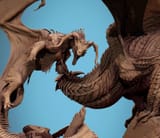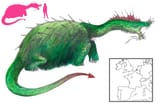>>95851238
>>95851267
Educated gents, though it may have started to be important by the 16th century
>>95848667
>>95851157
Gee, Anon, it's not like that same Western heraldic tradition you're invoking as evidence against wyverns being dragons didn't define a wyvern as a two-legged dragon.
>Wyvern or Wivern.—A monster of the dragon order
>Heraldry, Ancient and Modern, S. T. Aveling, 1890
The Western heraldic tradition mostly calls the two-legged dragon a dragon with only British heralds using wyvern to blazon a two-legged dragon. Even then, as pic related shows, it's use was inconsistent.
Before you start thinking
>That blazon at bottom left says wyvern not dragon so you've proved yourself wrong
that would be to ignore several facts.
The three other two-legged dragons blazoned as dragons which proves that two-legged dragons are called dragons.
In English heraldry, as quoted, wyverns are dragons, just a subtype of dragon with its own name.
The entire principle of canting arms.
Blazon of English arms directly calling wyverns dragons.
In case you are not familiar with canting arms, and even if you are others reading this may not, that coat of arms is a play on words. It is the arms of the family of Drake of Ashe. Drake means dragon. The herald who granted those arms used a wyvern on the understanding that intelligent people would understand that a two-legged dragon is a dragon.
So much so is it a dragon that it is called a dragon in a manuscript of the College of Arms dated prior to the end of June 1581. Sir Francis Drake claimed kinship with the Drakes of Ashe to the point that he used, wrongly according to both the heralds and the head of the Drake family who punched Francis in court possibly in front of Elizabeth herself, their arms blazoned
>Argent, a wyver dragon gewels
In contemporary spelling
>Agent, a wyvern dragon gules
Of late it may be just wyvern and people now say it is different, but wyvern has been understood as dragon for a long, long time.



